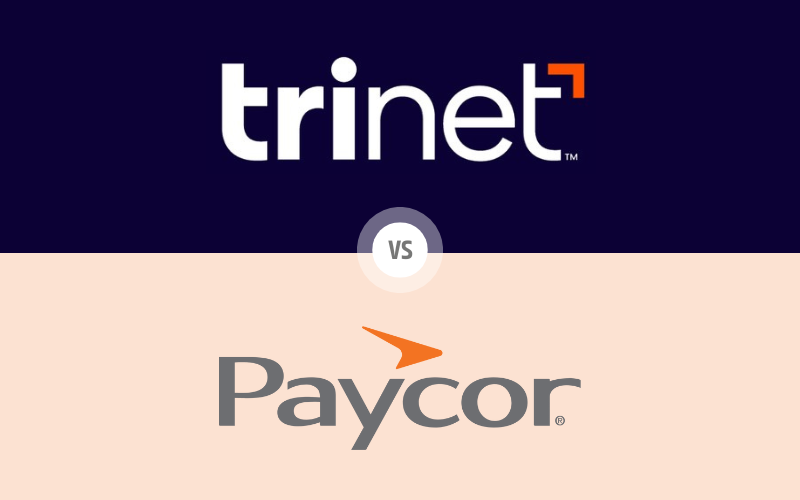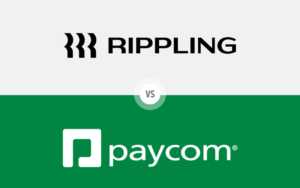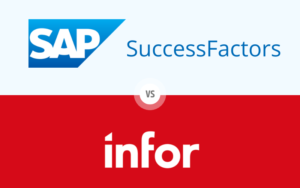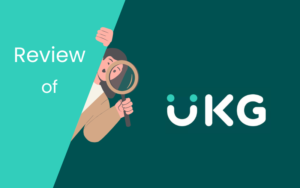Choosing between TriNet vs Paycor for your Human Capital Management (HCM) needs is a crucial decision that impacts how effectively you can manage your workforce and streamline HR processes. This blog post offers a comprehensive comparison of TriNet and Paycor, detailing their features across various aspects such as user interface, core HR functions, payroll management, and more. By understanding the strengths and weaknesses of each platform, you can make an informed decision that best fits the unique needs of your organization. Whether you are a small business or a large enterprise, this guide will help you assess which HCM system is the right choice for optimizing your HR operations.
Table of Contents
User Interface and User Experience
When evaluating TriNet vs Paycor platforms, it’s crucial to understand the differences in User Interface (UI) and User Experience (UX). Each system offers unique elements catering to specific user preferences and operational requirements, making this comparison vital for an informed HCM software decision.

TriNet User Interface and User Experience
TriNet is known for its straightforward and intuitive interface, tailored for simplicity and efficiency. This design approach particularly appeals to small and mid-sized businesses prioritizing ease of use and swift deployment. However, some users note that the UI can feel somewhat dated compared to more modern platforms.
Key Features of TriNet UI/UX:
- Minimalist Design: Focuses on a clean, uncluttered interface that minimizes distractions and maximizes usability.
- User-Centric Navigation: Provides easy access to necessary tools, ensuring efficient completion of HR tasks.
- Responsive Design: Offers a consistent experience across devices, facilitating on-the-go access, though some users find the mobile experience less modern than competitors.
While TriNet’s simplicity is a strength, it’s worth noting that some users have reported challenges with customer support, particularly phone support navigation, which can impact the overall user experience.
Paycor User Interface and User Experience
Paycor offers a robust, feature-rich interface designed for larger enterprises with complex HR management needs. Its platform is highly customizable, allowing it to meet diverse organizational requirements and adapt as those needs evolve.
Key Features of Paycor UI/UX:
- High Customizability: Enables extensive customization of dashboards and modules, tailoring the system to meet specific organizational needs.
- Advanced Features: Incorporates a broad range of tools and functionalities capable of managing intricate HR tasks.
- Interactive Elements: Utilizes cutting-edge UI technologies to enhance data visualization and user engagement, facilitating strategic decision-making.
Paycor’s platform is highly regarded for its comprehensive HR solutions and user-friendly interface. However, some users have experienced challenges with customer support and implementation processes, which are important factors to consider.
Comparison and Conclusion
Choosing between TriNet and Paycor hinges on a thorough assessment of each platform’s UI and UX capabilities relative to your company’s size, operational complexity, and specific HR team needs.
TriNet’s UI is ideally suited for organizations that prioritize straightforward functionality and ease of use. It’s an excellent choice for those who need a quick setup with minimal training. The streamlined approach helps users navigate the system efficiently, boosting productivity without a steep learning curve. However, potential users should consider the reported issues with customer support and the less modern feel of the interface.
On the other hand, Paycor’s customizable interface serves well for larger organizations that require detailed control over their HCM processes. It supports a greater degree of customization and offers advanced features beneficial for handling multi-faceted HR operations across various departments or locations. Paycor’s platform is especially valuable for those who need a scalable solution that can grow and adapt to changing HR demands. However, be prepared for a potentially more complex implementation process.
In conclusion, your selection between TriNet and Paycor should align with your current and anticipated needs. For businesses seeking a user-friendly, efficient, and quick-to-implement system, TriNet offers a solid solution, despite some UI limitations. Conversely, if your enterprise demands a robust, customizable, and feature-intensive platform capable of supporting a larger or more complex HR landscape, Paycor is likely the more suitable choice, keeping in mind potential implementation challenges. The optimal decision will blend functionality, scalability, and user experience to support your organization’s unique goals and HR strategies, while also considering factors like customer support quality and implementation processes.
Core HR Functions
Understanding the core Human Resources (HR) functionalities is critical when comparing TriNet vs Paycor. Both platforms offer comprehensive solutions, but their approaches cater to different organizational needs and priorities. This section delves into their core HR functions to help you determine which software is the better fit for your business operations.

TriNet Core HR Functions
TriNet provides a robust set of core HR functionalities designed to support mainly small to mid-sized businesses. Its integrated approach aims to streamline HR operations, making HR management both efficient and user-friendly. However, it’s important to verify specific features directly with TriNet, as offerings can evolve over time.
Key Features of TriNet Core HR Functions:
- Comprehensive Employee Records: Easy access to all employee data in one place, allowing for efficient management of employee information from hiring through retirement.
- Automated Workflows: Simplifies common HR processes such as onboarding, offboarding, and employee status changes, reducing manual work and potential for errors.
- Regulatory Compliance: Stays up-to-date with the latest HR compliance requirements and automates many compliance tasks, ensuring businesses meet all legal standards without extensive manual oversight.
Paycor Core HR Functions
Paycor’s platform is designed to accommodate the needs of larger organizations or those with more complex HR requirements. It offers a wide array of customizable features that can scale as a business grows. Again, verifying specific features with Paycor is recommended for the most accurate and up-to-date information.
Key Features of Paycor Core HR Functions:
- Dynamic Employee Profiles: Provides detailed profiles that include not just basic information but also track career development, performance, and training milestones.
- Scalable HR Processes: From recruitment to retirement, Paycor offers tools that can be customized to support the unique workflows of any organization, enhancing the ability to manage a large and diverse workforce.
- Advanced Reporting Capabilities: Offers extensive analytics and reporting features that help HR departments make data-driven decisions and improve HR strategies.
Comparison and Conclusion
When deciding between TriNet vs Paycor for core HR functions, consider the size and complexity of your operations. TriNet is an excellent choice for smaller businesses or those that require straightforward, no-frills HR management. Its tools are easy to use and quick to implement, which can significantly streamline daily HR tasks without overwhelming users.
Conversely, Paycor is suitable for larger businesses or those that anticipate needing a more robust set of HR tools. Its strength lies in its ability to handle complex HR functions with ease, providing detailed insights and reports that support strategic decision-making. Paycor’s customizable nature makes it a scalable solution that can adapt to the evolving needs of growing businesses.
In summary, the choice between TriNet and Paycor should align with your business’s current needs and future growth expectations. TriNet offers simplicity and efficiency, perfect for smaller businesses, while Paycor provides comprehensive and scalable solutions ideal for larger enterprises with complex HR requirements. Each platform delivers exceptional tools, but their best use case depends on your organization’s specific HR operational needs.
Payroll Management
Payroll management is a critical aspect of any Human Capital Management (HCM) system. This comparison between TriNet vs Paycor focuses on their payroll functionalities to help you understand which platform might be the best fit for managing your organization’s payroll effectively and efficiently.

TriNet Payroll Management
TriNet is designed to accommodate the payroll needs of small to mid-sized businesses with a focus on simplicity and integration. Its payroll management system is part of a broader suite of HR services.
Key Features of TriNet Payroll Management:
- Integrated Payroll Processing: TriNet offers payroll processing as part of its core features, alongside PTO management, benefits administration, and 401(k) plans.
- Streamlined Setup: TriNet has no setup fee, which can be advantageous for smaller businesses looking to implement a new payroll system.
- Comprehensive HR Services: As a Professional Employer Organization (PEO), TriNet provides a wide range of HR services beyond just payroll, which can be beneficial for businesses seeking an all-in-one solution.
Paycor Payroll Management
Paycor’s payroll management system is robust and scalable, suitable for medium to large organizations that need comprehensive payroll solutions with advanced features and customization options.
Key Features of Paycor Payroll Management:
- Flexible Payroll Features: Paycor provides a platform that can handle payroll requirements for teams ranging from 50 to 500 employees, with the capability to accommodate organizations up to 2,500 employees.
- Mobile Accessibility: Paycor offers a mobile digital wallet that allows employees to access pay stubs and adjust tax withholdings, enhancing user experience and accessibility.
- Optional Setup Fees: Paycor has optional setup fees, which may provide more customization options but should be factored into the overall cost consideration.
Comparison and Conclusion
When comparing TriNet vs Paycor in terms of payroll management, your choice should depend on your company’s size, the complexity of your payroll needs, and your budget.
TriNet is well-suited for smaller businesses looking for an integrated HR solution that includes payroll management. Its no-setup-fee approach and comprehensive HR services make it an attractive option for companies seeking simplicity and all-in-one functionality.
On the other hand, Paycor is ideal for larger organizations that require detailed and customizable payroll options. Its ability to handle larger employee numbers and provide mobile accessibility makes it a strong candidate for businesses with more complex payroll requirements.
It’s worth noting that user satisfaction ratings favor Paycor, with a higher likelihood to recommend score (7.3) compared to TriNet (1.6). However, some users have reported challenges with Paycor’s customer support and implementation process, which should be considered in your decision-making.
Ultimately, whether TriNet or Paycor is the better choice for your payroll management needs depends on the specific requirements of your business, including the number of employees, the complexity of your payroll processes, and your budget. Both platforms offer robust payroll solutions, but their best use will vary based on the scale and intricacies of your operations.
Time and Attendance Tracking
Effective time and attendance tracking is crucial for accurate payroll processing and regulatory compliance. This comparison of TriNet vs Paycor focuses on how each platform manages time and attendance, a key factor in optimizing workforce management and operational efficiency.

TriNet Time and Attendance Tracking
TriNet offers a straightforward time and attendance system that is well-suited for small to mid-sized businesses. The system integrates smoothly with TriNet’s payroll and HR functionalities, ensuring a unified approach to workforce management.
Key Features of TriNet Time and Attendance Tracking:
- Automated Timekeeping: TriNet’s system automates the recording of time and attendance, reducing manual entry errors and streamlining the process from clock-in to payroll.
- Mobile Accessibility: Employees can clock in and out using their mobile devices, providing convenience and flexibility, particularly for remote or field workers.
- Compliance Features: The platform helps businesses adhere to labor laws by automating the tracking of hours worked, overtime, and mandatory breaks, thus minimizing compliance risks.
Paycor Time and Attendance Tracking
Paycor’s time and attendance solutions are designed to handle the complex needs of medium to large organizations. The system offers robust customization options and advanced features that cater to a diverse range of business types and operational scales.
Key Features of Paycor Time and Attendance Tracking:
- Sophisticated Scheduling Tools: Paycor provides advanced scheduling capabilities, including shift swapping, schedule distribution, and real-time labor forecasting, which are essential for businesses with complex scheduling needs.
- Integrated Workforce Management: The system fully integrates with Paycor’s payroll and HR modules, facilitating seamless data flow and reducing the potential for errors across systems.
- Detailed Reporting: Paycor offers comprehensive analytics and reporting on time and attendance data, allowing managers to gain insights into labor trends, productivity, and cost management.
Comparison and Conclusion
The choice between TriNet vs Paycor for time and attendance tracking should align with the size of your business and the complexity of your timekeeping needs. TriNet’s system is ideal for smaller businesses seeking an easy-to-use, integrated solution that covers all the basics of time tracking without additional complexity. Its mobile functionality and compliance tools make it a solid choice for businesses that need straightforward, reliable timekeeping.
In contrast, Paycor is better suited for larger organizations or those with more intricate scheduling and workforce management needs. Its advanced scheduling tools and integrated workforce management capabilities offer the flexibility and depth required to handle varied and dynamic work environments. Paycor’s robust reporting functions also provide valuable insights that can help optimize labor costs and improve operational efficiency.
It’s worth noting that user satisfaction ratings favor Paycor, with a higher likelihood to recommend score (7.3) compared to TriNet (1.6). However, some users have reported challenges with Paycor’s customer support and implementation process, which should be considered in your decision-making.
Ultimately, deciding between TriNet and Paycor will depend on your specific requirements. For businesses with straightforward needs or smaller workforces, TriNet offers simplicity and efficiency. For larger enterprises or those with complex scheduling demands, Paycor provides the scalability and detailed control needed to manage a diverse workforce effectively. Both platforms offer comprehensive time and attendance tracking features, but their optimal utilization will vary depending on your organizational needs and priorities.
Benefits Administration
Benefits administration is a crucial aspect of Human Capital Management (HCM), impacting employee satisfaction and retention. In this section, we compare TriNet vs Paycor to understand how each platform handles benefits management, which can help employers attract and maintain top talent.

TriNet Benefits Administration
TriNet’s benefits administration is designed to be streamlined and user-friendly, ideal for small to mid-sized businesses. It simplifies the management of benefits as part of its comprehensive PEO (Professional Employer Organization) services.
Key Features of TriNet Benefits Administration:
- Integrated Benefits Management: TriNet offers benefits management as part of its core features, ensuring consistency across HR functions.
- PEO Services: As a PEO, TriNet provides access to a wider range of benefits options that may be particularly advantageous for smaller businesses.
Paycor Benefits Administration
Paycor’s benefits administration features are designed to cater to medium to large organizations, offering tools that can accommodate a diverse workforce.
Key Features of Paycor Benefits Administration:
- Comprehensive Benefits Management: Paycor includes benefits management as part of its HR suite, suitable for organizations with 50 to 2,500 employees.
- Scalable Solutions: The platform is designed to grow with your business, accommodating increasing complexity in benefits administration as your organization expands.
- Employee Self-Service: While not specifically mentioned in the search results, it’s likely that Paycor offers some form of employee self-service for benefits, given its focus on larger organizations.
Comparison and Conclusion
Choosing between TriNet vs Paycor for benefits administration should depend on the size of your business and the complexity of your benefits needs. TriNet, with its PEO services, may be particularly advantageous for smaller businesses looking for comprehensive HR solutions that include robust benefits options. Its integrated approach could simplify benefits management for companies with limited HR resources.
Conversely, Paycor is designed to cater to larger organizations or those anticipating significant growth. Its scalability makes it a strong option for businesses that need a benefits administration system that can evolve with their changing needs.
It’s worth noting that user satisfaction ratings favor Paycor, with a higher likelihood to recommend score (7.3) compared to TriNet’s HR Platform (1.6). However, these scores reflect overall platform satisfaction and not specifically benefits administration features.
In summary, both TriNet and Paycor offer solutions for benefits administration, but their strengths cater to different types of businesses. TriNet provides a comprehensive PEO solution that could be particularly beneficial for smaller companies, while Paycor offers scalable features ideal for larger enterprises or those expecting growth.
Performance Management
Effective performance management is essential for fostering employee growth and achieving organizational goals. In this comparison of TriNet vs Paycor, we examine how each platform supports the performance management process, catering to different business sizes and needs.

TriNet Performance Management
TriNet offers performance management solutions as part of its comprehensive HR services, which are particularly suitable for small to mid-sized businesses. While specific details about TriNet’s performance management features are not available in the provided search results, we can infer some likely offerings based on industry standards.
Key Features of TriNet Performance Management:
- Integrated HR Solutions: As a PEO, TriNet integrates performance management with other HR functions for a cohesive approach.
- User-Friendly Interface: Given its focus on smaller businesses, TriNet offers a straightforward, easy-to-use performance management system.
- Compliance Support: TriNet’s PEO services include ensuring performance management processes comply with relevant regulations.
Paycor Performance Management
Paycor’s performance management system is designed to accommodate the needs of medium to large organizations, offering a robust set of tools that can be customized to suit diverse and complex requirements.
Key Features of Paycor Performance Management:
- Efficiency and Performance Tools: Paycor offers features specifically designed to enhance efficiency and manage performance effectively.
- Leader Empowerment: The platform focuses on empowering leaders with personalized coaching and leader insights, supporting data-driven decision-making.
- Scalable Solutions: Paycor’s system is suitable for teams ranging from 50 to 500 employees, with the capability to accommodate organizations up to 2,500 employees.
Comparison and Conclusion
When evaluating TriNet vs Paycor for performance management, the decision should align with your organization’s size and the complexity of your HR processes. TriNet, as a PEO, may be ideal for smaller businesses looking for an integrated HR solution that includes performance management. Its approach likely focuses on simplicity and efficiency, suitable for companies with straightforward performance management needs.
On the other hand, Paycor is better suited for larger organizations that require a more detailed and flexible approach to performance management. Its focus on empowering leaders with insights and coaching tools makes it a robust choice for businesses that need to closely manage and analyze employee performance across larger teams.
It’s worth noting that user satisfaction ratings favor Paycor, with a higher likelihood to recommend score (7.3) compared to TriNet’s HR Platform (1.6). However, these scores reflect overall platform satisfaction and not specifically performance management features.
In summary, both platforms offer performance management solutions, but they cater to different organizational needs. TriNet’s integrated PEO approach may be beneficial for smaller companies, while Paycor’s comprehensive and scalable system is well-equipped to meet the needs of larger, more complex organizations.
Talent Management and Recruiting
In the competitive landscape of talent acquisition and management, choosing the right HCM platform is pivotal. This comparison between TriNet vs Paycor focuses on their capabilities in talent management and recruiting, helping you determine which system best aligns with your organization’s needs.

TriNet Talent Management and Recruiting
TriNet’s talent management and recruiting features are designed to support small to mid-sized businesses.
Key Features of TriNet Talent Management and Recruiting:
- Integrated HR Solutions: As a PEO, TriNet offers talent management and recruiting tools that integrate seamlessly with its other HR functions.
- Streamlined Processes: TriNet provides straightforward tools for job posting, applicant tracking, and basic employee development.
- Compliance Support: TriNet’s PEO services include ensuring talent management processes comply with relevant regulations.
Paycor Talent Management and Recruiting
Paycor’s system is equipped to handle the talent management needs of medium to large organizations, offering comprehensive tools that support a wide array of processes from recruiting to employee development.
Key Features of Paycor Talent Management and Recruiting:
- Smart Source Recruiting: Paycor includes an advanced Applicant Tracking System (ATS) designed to streamline the hiring process.
- Scalable Solutions: Suitable for teams ranging from 50 to 500 employees, with the capability to accommodate organizations up to 2,500 employees.
- Leader Empowerment: Focuses on empowering leaders with personalized coaching and insights, supporting data-driven talent management decisions.
- Mobile Accessibility: Offers a mobile digital wallet feature, enhancing the employee experience which is crucial for talent retention.
Comparison and Conclusion
When comparing TriNet vs Paycor in terms of talent management and recruiting, your choice should be influenced by the size of your organization and the complexity of your talent management needs. TriNet, as a PEO, may be well-suited for smaller companies that need a streamlined, integrated approach to recruiting and talent development. Its system likely simplifies the hiring process and provides necessary tools for employee growth, making it ideal for businesses with straightforward talent management requirements.
Conversely, Paycor is more appropriate for larger organizations or those with more comprehensive and varied talent management needs. Its Smart Source recruiting, scalability for larger teams, focus on leader empowerment, and mobile features offer the flexibility needed to manage a complex and dynamic workforce effectively.
In summary, both TriNet and Paycor provide talent management and recruiting capabilities, but their optimal use depends on the specific demands of your business. TriNet’s integrated PEO approach may benefit smaller operations, while Paycor delivers depth and customization that can support larger, more complex organizational structures.
Learning and Development
Learning and development (L&D) are critical for fostering employee growth and maintaining a competitive edge. This section delves into the L&D capabilities of TriNet vs Paycor, exploring how each platform supports continuous learning and professional development.

TriNet Learning and Development
TriNet’s approach to learning and development is streamlined and efficient, ideally suited for small to mid-sized businesses.
Key Features of TriNet Learning and Development:
- Integrated Learning Management System (LMS): TriNet includes a basic LMS that integrates seamlessly with its other HR functions, making it easier to track and manage employee training across the organization.
- On-Demand Training Resources: TriNet offers a variety of pre-built training courses and materials that employees can access to improve their skills at their own pace.
- Performance-Driven Learning: TriNet’s L&D tools are linked to performance management processes, allowing for targeted developmental activities based on individual performance reviews.
Paycor Learning and Development
Paycor’s L&D functionalities are robust and highly customizable, designed to meet the diverse needs of medium to large organizations. The platform offers comprehensive tools to create, manage, and optimize training programs that align with strategic business goals.
Key Features of Paycor Learning and Development:
- Advanced Learning Management System (LMS): Paycor features a sophisticated LMS that supports a wide range of learning modalities, including online, in-person, and blended learning environments.
- Customizable Learning Paths: Allows administrators to create personalized learning paths for employees, which can be tailored based on job roles, career goals, or specific skills gaps.
- Analytics and Reporting: Provides detailed analytics on training effectiveness, employee engagement with learning materials, and the impact of training on performance metrics.
Comparison and Conclusion
When comparing TriNet vs Paycor for learning and development, consider the scale of your L&D needs and the sophistication required in your training programs. TriNet is well-suited for organizations that need straightforward, integrated L&D tools that are easy to deploy and manage. Its system is designed to support essential training initiatives with minimal complexity, making it ideal for smaller businesses or those with simpler training requirements.
Conversely, Paycor is better equipped to handle the complex and varied L&D demands of larger organizations. Its extensive customization capabilities, coupled with a powerful LMS, allow companies to develop comprehensive, multi-faceted training programs that can be closely aligned with strategic objectives and individual career development plans.
Ultimately, the choice between TriNet and Paycor should align with your organization’s L&D priorities. For businesses seeking basic, easy-to-use L&D functionalities, TriNet offers an efficient solution. For those requiring a more detailed and adaptable approach to foster an advanced learning culture, Paycor provides the necessary tools and flexibility to achieve these goals effectively. Both platforms offer valuable learning and development opportunities, but their best application will depend on the specific needs and scope of your organization’s training strategies.
Reporting and Analytics
In the realm of Human Capital Management (HCM), the ability to harness data through effective reporting and analytics is crucial for strategic decision-making. This detailed comparison between TriNet vs Paycor explores how each platform supports organizations in managing and analyzing HR-related data.

TriNet Reporting and Analytics
TriNet’s reporting and analytics functionalities are designed to meet the needs of small to mid-sized businesses, providing essential insights into workforce trends and HR metrics.
Key Features of TriNet Reporting and Analytics:
- Standard Reports: TriNet provides a range of pre-built reports covering common HR metrics such as headcount, turnover, and employee demographics.
- Basic Data Visualization: TriNet offers simple dashboards to display relevant HR data in a visual format.
- Data Export Options: TriNet supports the ability to export data into various formats for further analysis or integration with other business systems.
Paycor Reporting and Analytics
Paycor’s reporting and analytics capabilities are robust and highly sophisticated, suitable for medium to large organizations that require deep data insights to inform HR strategies. The platform offers advanced tools for detailed analysis and customization.
Key Features of Paycor Reporting and Analytics:
- Advanced Analytics: Includes analytics tools for compensation planning and monitoring pay equity, providing valuable insights for strategic decision-making.
- Scalable Solutions: Suitable for teams ranging from 50 to 500 employees, with the capability to accommodate organizations up to 2,500 employees, ensuring scalability in reporting and analytics.
- General Ledger Integration: Paycor integrates general ledger data, which can enhance financial reporting capabilities.
Comparison and Conclusion
The decision between TriNet vs Paycor for reporting and analytics should depend on the complexity of your data needs and the sophistication required in your analytics tools. TriNet is likely well-suited for businesses that need straightforward, easy-to-use reporting functionalities. Its tools are ideal for organizations that require regular reporting on standard HR metrics without the need for extensive customization.
Conversely, Paycor is tailored for larger organizations or those that demand a higher level of detail and analytical depth from their reporting systems. Its advanced analytics capabilities, particularly in areas like compensation planning and pay equity monitoring, are excellent for businesses that rely on data-driven decision-making to guide strategic HR initiatives.
In conclusion, both TriNet and Paycor provide valuable reporting and analytics features, but their optimal use will depend on your organization’s specific requirements. For simplicity and user-friendliness, TriNet likely offers a practical solution. For comprehensive data analysis and customized reporting, Paycor delivers extensive tools and capabilities that can significantly enhance your HR data management strategy.
Compliance and Security
Ensuring compliance with regulatory requirements and maintaining robust security protocols are essential aspects of Human Capital Management (HCM) systems. This comparison between TriNet vs Paycor focuses on how each platform might address compliance and security, helping organizations safeguard sensitive employee data and adhere to legal standards.

TriNet Compliance and Security
TriNet provides compliance and security features suitable for small to mid-sized businesses.
Key Features of TriNet Compliance and Security:
- PEO Services: TriNet offers compliance support as part of its comprehensive HR services.
- Data Protection: TriNet implements measures to protect sensitive employee information, which is standard in the industry.
- Regulatory Updates: TriNet provides updates on relevant employment laws and regulations as part of its PEO services.
Paycor Compliance and Security
Paycor’s compliance and security features are designed to meet the needs of medium to large organizations, offering tools that can handle complex regulatory environments and larger volumes of sensitive data.
Key Features of Paycor Compliance and Security:
- Scalable Solutions: Suitable for teams ranging from 50 to 500 employees, with the capability to accommodate organizations up to 2,500 employees, suggesting scalable compliance and security measures.
- Efficiency Tools: Offers features for efficiency and better performance management, which may include some compliance-related functionalities.
- Data Management: Paycor provides secure data management solutions.
Comparison and Conclusion
When deciding between TriNet vs Paycor for compliance and security, consider the scale of your operations and the complexity of your compliance needs. TriNet, as a PEO, may offer an excellent solution for smaller businesses that need straightforward, reliable compliance and security features as part of a comprehensive HR service package.
In contrast, Paycor might be more suitable for larger organizations or those with more complex HR needs. Its scalability and focus on efficiency suggest that it could provide robust compliance and security measures for growing businesses.
In summary, both platforms likely provide compliance and security capabilities as part of their comprehensive HR solutions, but their suitability will vary based on organizational size and specific needs. TriNet’s PEO services might simplify compliance and security for smaller entities, while Paycor’s scalable platform could support larger organizations with evolving requirements.
Integration and Compatibility
In today’s digital ecosystem, the integration and compatibility of Human Capital Management (HCM) systems with other business software are crucial for seamless operations. This comparison between TriNet vs Paycor focuses on how each platform might enable organizations to connect and synchronize their HCM functions with other systems.

TriNet Integration and Compatibility
TriNet offers integration capabilities that cater primarily to small to mid-sized businesses, emphasizing ease of use and straightforward compatibility with popular business tools and software.
Key Features of TriNet Integration and Compatibility:
- Pre-built Integrations: TriNet provides a range of pre-built integrations with major business applications such as Microsoft Office 365, Google Workspace, and leading payroll systems.
- API Access: TriNet offers API (Application Programming Interface) access that allows businesses to create custom integrations with other software.
- User-Friendly Interface: Designed to be user-friendly, ensuring that even users with limited technical expertise can manage integrations without extensive IT support.
Paycor Integration and Compatibility
Paycor’s integration capabilities are robust and extensive, designed to support medium to large organizations with complex systems. It offers advanced options that cater to diverse operational needs, making it suitable for companies that require deep integration across multiple platforms.
Key Features of Paycor Integration and Compatibility:
- Extensive API Library: Provides a comprehensive library of APIs, supporting deeper and more customizable integrations with a wide variety of systems, from financial software to specialized HR tools.
- Third-Party Integration Support: Partners with numerous third-party vendors to offer seamless integration capabilities that extend the functionality and reach of Paycor’s HCM solutions.
- Advanced Customization Options: Allows for high levels of customization in how integrations are set up and maintained, enabling businesses to tailor the system to precisely fit their unique processes and workflow requirements.
Comparison and Conclusion
Choosing between TriNet vs Paycor for integration and compatibility should depend on your organization’s size, the complexity of your existing systems, and your specific integration needs. TriNet is ideal for smaller organizations or those with straightforward system landscapes that require basic integration capabilities. Its pre-built integrations and accessible API make it easy to connect TriNet with commonly used software, ensuring quick setup and minimal disruption.
Conversely, Paycor is well-suited for larger enterprises or organizations with intricate system architectures. Its extensive API library and strong third-party integration support are perfect for businesses that need a high degree of customization and control over their integrations. This makes Paycor a strong option for companies that prioritize flexibility and comprehensive connectivity across their software ecosystems.
In summary, both TriNet and Paycor offer effective solutions for integration and compatibility, but they cater to different types of businesses. TriNet simplifies integration for less complex environments, making it accessible and practical for smaller companies. Paycor provides advanced integration capabilities that meet the needs of larger organizations with more demanding integration requirements. Select the platform that aligns best with your integration strategy and business needs to maximize the efficiency and effectiveness of your HCM system.
Customer Support and Service
Effective customer support and service are crucial components that can significantly enhance the user experience and operational efficiency of Human Capital Management (HCM) systems. In this section, we explore how TriNet vs Paycor differ in their approach to customer support and the kind of services they offer to their clients.

TriNet Customer Support and Service
TriNet is known for its responsive and accessible customer support, tailored primarily to meet the needs of small to mid-sized businesses. It focuses on providing efficient service to help organizations resolve issues and maximize their use of the HCM platform.
Key Features of TriNet Customer Support and Service:
- Responsive Customer Service: Users report good relationships with their customer service representatives, indicating a focus on client satisfaction.
- Personalized Assistance: TriNet offers personalized support to address specific issues or questions, though details are not explicitly provided in the available information.
- Support Rating: TriNet has a support rating of 7.0 out of 10 based on 685 user ratings, suggesting generally positive experiences with their customer service.
Paycor Customer Support and Service
Paycor’s customer support is designed to cater to medium to large businesses, offering support options that can handle the complexities and scale of larger organizational needs. However, some users have reported challenges with support responsiveness and implementation.
Key Features of Paycor Customer Support and Service:
- Scalable Support: Suitable for teams ranging from 50 to 500 employees, with the capability to accommodate organizations up to 2,500 employees.
- Implementation Challenges: Some users have noted extended wait times for customer support and difficulties during the implementation process.
- Support Rating: Paycor has a support rating of 5.0 out of 10 based on 56 user ratings, indicating room for improvement in their customer service offerings.
Comparison and Conclusion
When evaluating TriNet vs Paycor in terms of customer support and service, the size of your organization and the complexity of your needs play significant roles. TriNet appears to be well-suited for smaller businesses that require straightforward, effective support to ensure smooth operations. Its higher support rating suggests that users generally have positive experiences with their customer service.
On the other hand, Paycor is designed for larger organizations but has faced some challenges in customer support. While it offers scalable solutions for growing businesses, the lower support rating and reported implementation difficulties indicate that there may be areas for improvement in their customer service offerings.
Ultimately, both TriNet and Paycor offer customer support and service frameworks, but their effectiveness may vary. Choose TriNet if you value responsive customer service and are a smaller to mid-sized business. Consider Paycor if you’re a larger organization and are willing to navigate potential support challenges in exchange for a platform that can accommodate more complex HR needs.
Pricing and Cost-effectiveness
Evaluating the pricing and cost-effectiveness of Human Capital Management (HCM) systems is crucial for businesses to ensure they receive value from their investment. This comparison between TriNet vs Paycor provides insights into their pricing structures and overall cost-effectiveness, helping you decide which platform best fits your budget and business needs.

TriNet Pricing and Cost-effectiveness
TriNet is designed to cater primarily to small to mid-sized businesses, offering a pricing model that aligns with the needs of organizations looking for affordability without sacrificing essential HCM functionalities.
Key Features of TriNet Pricing and Cost-effectiveness:
- No Setup Fee: TriNet offers its services without an initial setup fee, which can be attractive for businesses looking to minimize upfront costs.
- Transparent Pricing Structure: TriNet offers a clear pricing model to help businesses plan their expenses.
- Integrated Services: TriNet provides bundled HR services, which may offer cost advantages for some businesses.
For more information about pricing, please visit TriNet’s website.
Paycor Pricing and Cost-effectiveness
Paycor’s pricing structure is suited for medium to large businesses that require a robust HCM solution with advanced features and customization options.
Key Features of Paycor Pricing and Cost-effectiveness:
- Per-User, Per-Month Model: Paycor’s pricing generally starts at $99 per month, per user.
- Tiered Pricing Structure: For companies with under 50 employees, pricing is straightforward and per employee. For organizations with more than 50 employees, custom pricing is available through a Paycor representative.
- Optional Setup Fee: Paycor has an optional setup fee, which may provide additional customization or implementation support.
- Scalability: Suitable for teams ranging from 50 to 500 employees, with the capability to accommodate organizations up to 2,500 employees.
For more information about pricing, please visit Paycor’s website.
Comparison and Conclusion
When choosing between TriNet vs Paycor based on pricing and cost-effectiveness, it’s important to consider the total value each platform can bring to your organization. TriNet, with its no setup fee policy, may offer an attractive option for smaller businesses or those with straightforward HR needs, potentially providing a cost-effective solution for essential workforce management features.
Conversely, Paycor’s tiered pricing structure and ability to accommodate larger organizations make it suitable for businesses with more complex HR requirements. The customizable pricing for companies with over 50 employees allows for flexibility, but may also require more detailed discussions with Paycor representatives to determine the final cost.
Ultimately, the decision should be based on a thorough assessment of your current and future HR needs, the scale of your operations, and your budget for HCM solutions. Both TriNet and Paycor offer competitive pricing models, but their cost-effectiveness will largely depend on how well their features align with your organizational goals and requirements.
User Reviews and Testimonials
User reviews and testimonials play a crucial role in understanding the real-world effectiveness and user satisfaction of Human Capital Management (HCM) systems. This comparative analysis of TriNet vs Paycor draws on user feedback to highlight the strengths and weaknesses of each platform from a customer perspective.

TriNet User Reviews and Testimonials
TriNet receives mixed feedback from its users, with some appreciating its services while others noting areas for improvement.
Highlights from TriNet User Reviews:
- Customer Support: Users frequently commend TriNet for its responsive customer service, with many reporting good relationships with their representatives.
- Marketplace Offerings: Customers appreciate TriNet’s marketplace, which offers discounts and sales for various services.
- Likelihood to Renew: TriNet has a likelihood to renew rating of 6.5 out of 10, indicating moderate satisfaction among current users.
- Areas for Improvement: The platform has a low likelihood to recommend score of 1.6 out of 10, suggesting that some users may have experienced challenges or limitations with the service.
Paycor User Reviews and Testimonials
Paycor generally receives favorable reviews, particularly from medium to large companies, though some users report challenges.
Highlights from Paycor User Reviews:
- User-Friendly Interface: Many users praise Paycor for its intuitive navigation and convenient employee self-service features.
- Feature Rich: Customers appreciate the comprehensive range of features that can be tailored to specific business needs.
- High Renewal Rate: Paycor boasts a very high likelihood to renew rating of 9.8 out of 10, indicating strong user satisfaction and loyalty.
- Challenges: Some users report extended wait times for customer support and difficulties during the implementation process.
- Recommendation Score: Paycor has a likelihood to recommend score of 7.3 out of 10, significantly higher than TriNet’s score.
Comparison and Conclusion
The user reviews for TriNet vs Paycor reflect distinct experiences and preferences. TriNet appears to have strengths in customer service and offers valuable marketplace discounts, which are appreciated by users. However, its low recommendation score suggests that some customers may have encountered limitations or issues with the platform.
Paycor, on the other hand, receives high marks for its user-friendly interface and comprehensive feature set. The platform’s high renewal rate and better recommendation score indicate strong overall satisfaction among its users. However, the reported challenges with customer support and implementation suggest there may be areas for improvement.
In summary, both TriNet and Paycor have their strengths and weaknesses according to user reviews. TriNet may be a good fit for businesses that value personalized customer service and marketplace offerings, but potential users should be aware of the low recommendation score. Paycor seems to be a strong choice for companies looking for a feature-rich, user-friendly platform, although they should be prepared for potential implementation challenges.
When choosing between these platforms, consider your specific needs, the size of your organization, and how much weight you place on factors like ease of use, customer support, and feature set. It’s also advisable to request demos or trials of both systems to get a firsthand experience before making a decision.
Conclusion
Deciding between TriNet vs Paycor for your Human Capital Management (HCM) system involves a comprehensive evaluation of your specific business needs, the scale of your operations, and the strategic objectives of your organization. Each platform offers distinct advantages that cater to different types of businesses, making the choice highly dependent on individual circumstances.
TriNet Overview
TriNet is ideally suited for small to mid-sized businesses seeking a straightforward, all-inclusive HCM solution. It excels in providing:
- An easy-to-use interface
- Responsive customer service (support rating of 7.0 out of 10)
- A bundled approach as a Professional Employer Organization (PEO)
- Core features including payroll processing, PTO, benefits management, and 401(k) plans
This makes TriNet a great choice for businesses that need a simple yet effective way to manage their HR needs without the complexities and customization that larger systems offer. However, it’s worth noting that TriNet has a relatively low likelihood to recommend score of 1.6 out of 10, suggesting some users may have experienced limitations or challenges.
Paycor Overview
Paycor is designed for medium to large organizations that require a robust, scalable HCM solution with extensive customization capabilities. Its strengths include:
- Suitability for teams of 50 to 500 employees, with capacity for up to 2,500 employees
- Advanced features like detailed analytics and extensive integration options
- Focus on empowering leaders with personalized coaching and insights
- A per-user, per-month pricing model, generally starting at $99 a month
- Higher likelihood to recommend score (7.3 out of 10)
Paycor is particularly beneficial for growing companies that need a system capable of adapting to evolving HR demands and complexities. However, it’s important to note that some users have reported challenges with customer support (support rating of 5.0 out of 10) and implementation processes.
Key Considerations
When making your decision, consider the following key points:
- Size and Complexity: Assess the size of your business and the complexity of your HR needs. Smaller companies with simpler requirements may find TriNet’s PEO services more than sufficient, while larger organizations with more intricate processes may require the advanced features offered by Paycor.
- Cost vs. Value: Evaluate the cost-effectiveness of each platform based on the value they provide in relation to your specific needs. Consider not only the upfront costs but also the long-term benefits such as improved efficiency, compliance, and employee satisfaction.
- User Feedback: Reflect on the user reviews and ratings provided. While Paycor has a higher likelihood to recommend score, TriNet scores better in customer support. These insights can help you understand how each system performs in real-world scenarios.
- Specific Features: Consider the unique offerings of each platform. TriNet’s PEO services might be attractive for businesses looking for comprehensive HR outsourcing, while Paycor’s focus on leadership empowerment and analytics might appeal to companies prioritizing data-driven decision-making.
Ultimately, the choice between TriNet and Paycor should align with your business’s current capabilities and future goals. Both platforms have proven track records and offer comprehensive tools to manage your workforce effectively. By carefully considering your specific needs and the detailed comparisons provided, you can select the HCM system that will best support your organization’s success and growth in the years to come.
![]()
![]() Read our full TriNet review
Read our full TriNet review
![]()
![]() Read our full Paycor review
Read our full Paycor review




